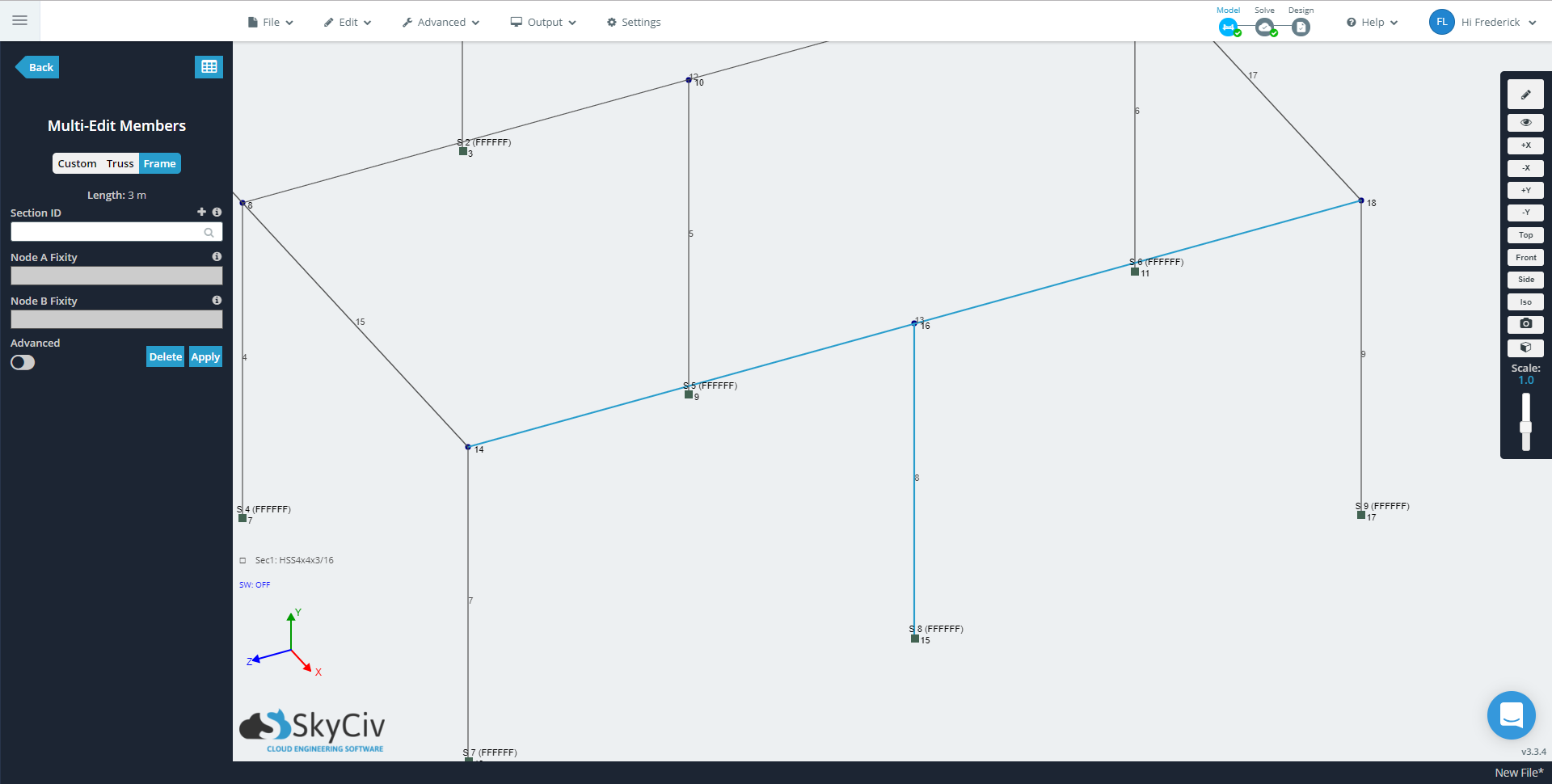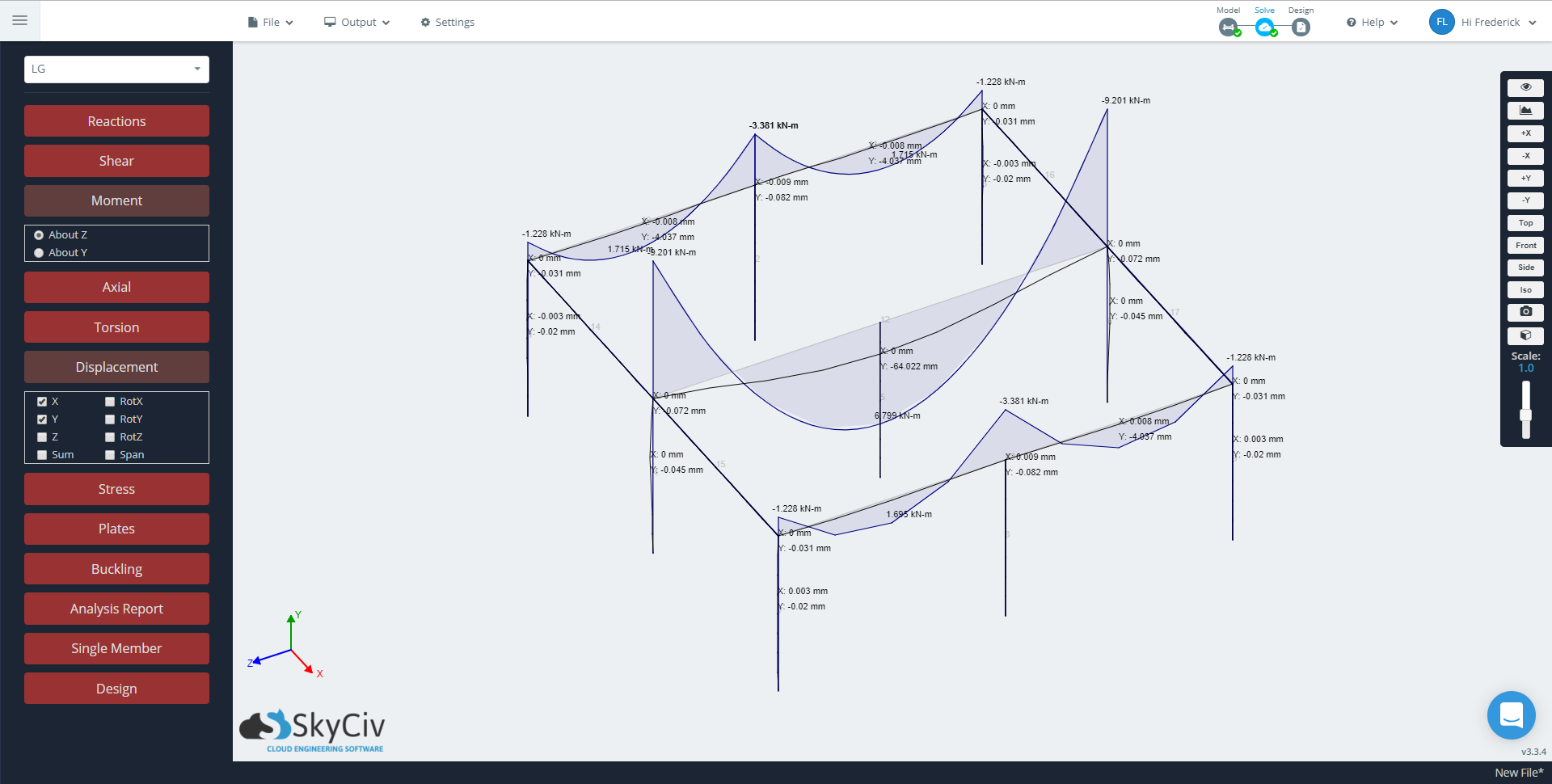Sürekli Üyeler vs. Normal Üyeler – her biri ne zaman kullanılmalı
Giriş
Bu makale üyelerin nasıl çalıştığına derinlemesine bir bakış sunacak (veya elementler) düğümler aracılığıyla birbirlerine bağlanma ve bunun SkyCiv Çözücüde nasıl ele alındığı. Düğümler üyeler arasındaki bağlantı noktasını işaretler, bunlar sertlik matrislerinin ayrılmasıdır.
Üyeler çok sayıda farklı türde olabilir. Aslında, Yapısal 3D aslında şu anki toplam 6 üye türleri. Şu an, genel olarak modelleme için temel üye türleri olduğundan iki tür üyeyi inceleyeceğiz. Yapısal 3D'de iki ana üye türü vardır: normal ve sürekli üyeler. Bu tartışma her ikisinin de SkyCiv çözümleyicisi tarafından nasıl ele alındığı konusunda daha derinlemesine olacaktır., ve birini diğerinden kullanmanın avantajları.
Normal Üyeler
Normal üyeler 'normal olarak' muamele gören unsurlardır’ Üyelerin geleneksel anlamda analiz edilmesi anlamında.
Geleneksel olarak, sonlu elemanlar analizi (ÇİRKİN) çözücüler doğrudan sertlik yöntemini kullanarak çalışır. Yapıdaki elemanların uygulanan yüklerine ve sertliğine bağlı olarak, Yapının yer değiştirmesi aşağıdaki denklemde gösterildiği gibi çözülebilir:
\(S=KD)
Nerede:
\(Q=\) sertlik vektörü
\(K=\) küresel sertlik matrisi (her üyenin sertlik matrisinden bir araya getirilmiş)
\(D=\) Bilinmeyen ve çözülmesi gereken bilinmeyen düğüm yer değiştirmelerinin vektörü
SkyCiv Structural 3D bu formülleri modele uygular ve her düğüm ve üyeden sonuçları alır..
Sürekli Üyeler
Yapısal 3B'deki sürekli üyeler, iki düğüm ile bir düğüm arasındaki bağlantıya izin veren bir üye türüdür.(s) üyeyle hiçbir düğüm bağlantısı olmayan. Düğüm bağlantıları, iki veya daha fazla üyeyi bağlamak için bir düğüm atandığında oluşur.

Aşağıdaki görselde en büyük saptıran üye 'Normal' olarak seçilmiştir.’ üye, bu nedenle sütunu uzunluğu boyunca tanımıyor. Üyeyi 'Sürekli' olarak değiştirme’ irade “Rüzgar hızlarını şu şekilde almak için Kanada konumlarına girin:” sütunun uzun üyesi, sınırlı sapma gösteren diğer iki üye için de durum aynıdır.

Her Üye Tipinin Avantajları ve Dezavantajları
Normal Üyeler
Normal üyelerle oluşturulan modellerin üçüncü taraf yapısal analiz yazılımlarıyla uyumlu olma olasılığı daha yüksektir. Diğer programlar, Structural 3D'nin uyguladığı şekilde sürekli üyeleri desteklemeyebileceğinden, sağlanan sonuçlar doğru olmayabilir.
Dışa aktarmadan önce modelde sürekli üye bulunmadığını kontrol etmek önemlidir..
Analiz açısından, üye basit üyelere bölündüğünden, Modeldeki değerlendirme noktalarının sayısı, iki veya daha fazla aralıkta aynı sayıda değerlendirme noktası taşıyan sürekli üyelerin aksine daha fazladır, sonuçların daha az ayrıntılı hale getirilmesi. Genel Çözücü Ayarlarında değerlendirme noktalarının sayısı artırılabilir, ancak bu, tüm üyelerin değerlendirme puanlarını kontrol ettiğinden, analiz daha uzun olabilir. Büyük ve karmaşık yapılarla çalışırken bu bir dezavantaj olabilir.

Sürekli Üyeler
Sürekli üyeler, diğer taraftan, modellemede verimliliğin artırılması söz konusu olduğunda çok faydalıdır. Sürekli üyeler normal üyelerle benzer bir model oluşturmak için gereken üye sayısını azaltır. Bu, projenizde mevcut olacak yük miktarını doğrudan etkiler.. Örneğin., Sürekli bir elemanı dağıtılmış bir yükle yüklemek vs her normal elemanı dağıtılmış bir yükle yüklemek.
Analizle ilgili olarak, Üye sayısının azaltılması dağınıklığı azaltır ve sonuçların yorumlanmasını ve sunulmasını kolaylaştırır. Daha az üyeye sahip olmak projenizdeki sonraki model öğelerinin miktarını azaltır, üye davranışlarını görmeyi kolaylaştırıyor. Örneğin, sürekli üyelerle, davranışı daha geniş bir aralıkta kontrol edebilirsiniz, aynı aralıktaki normal üyelerin birleşiminden ziyade.
Tasarım söz konusu olduğunda, Sürekli elemanlar, monolitik davranmaları amaçlandığından betonarme kirişler için mükemmeldir.. Bir açıklık genellikle aradaki kesiti değiştirmediğinden, belirli bir açıklık için gerekli çelik bölümün belirlenmesinde de faydalıdır. Örneğin, Kirişleri veya bunları çerçeveleyen elemanları tasarlarken neredeyse her zaman sürekli elemanlar tavsiye edilir, yani, zemin veya çatı çerçevesi.


